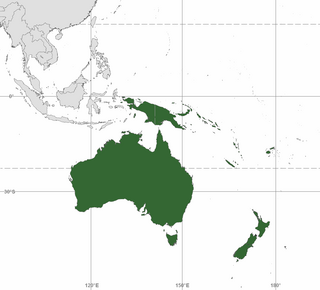
A chemist is a scientist trained in the study of chemistry. Chemists study the composition of matter and its properties. Chemists carefully describe the properties they study in terms of quantities, with detail on the level of molecules and their component atoms. Chemists carefully measure substance proportions, chemical reaction rates, and other chemical properties. In Commonwealth English, pharmacists are often called chemists.
January is the first month of the year in the Julian and Gregorian calendars and the first of seven months to have a length of 31 days. The first day of the month is known as New Year's Day. It is, on average, the coldest month of the year within most of the Northern Hemisphere and the warmest month of the year within most of the Southern Hemisphere. In the Southern hemisphere, January is the seasonal equivalent of July in the Northern hemisphere and vice versa.

A language family is a group of languages related through descent from a common ancestral language or parental language, called the proto-language of that family. The term "family" reflects the tree model of language origination in historical linguistics, which makes use of a metaphor comparing languages to people in a biological family tree, or in a subsequent modification, to species in a phylogenetic tree of evolutionary taxonomy. Linguists therefore describe the daughter languages within a language family as being genetically related.

A physicist is a scientist who specializes in the field of physics, which encompasses the interactions of matter and energy at all length and time scales in the physical universe. Physicists generally are interested in the root or ultimate causes of phenomena, and usually frame their understanding in mathematical terms. Physicists work across a wide range of research fields, spanning all length scales: from sub-atomic and particle physics, through biological physics, to cosmological length scales encompassing the universe as a whole. The field generally includes two types of physicists: experimental physicists who specialize in the observation of natural phenomena and the analysis of experiments, and theoretical physicists who specialize in mathematical modeling of physical systems to rationalize, explain and predict natural phenomena. Physicists can apply their knowledge towards solving practical problems or to developing new technologies.
A chief executive officer (CEO), chief administrator officer, central executive officer, or just chief executive (CE), is one of a number of corporate executives in charge of managing an organization – especially an independent legal entity such as a company or nonprofit institution. CEOs find roles in a range of organizations, including public and private corporations, non-profit organizations and even some government organizations. The CEO of a corporation or company typically reports to the board of directors and is charged with maximizing the value of the business, which may include maximizing the share price, market share, revenues or another element. In the non-profit and government sector, CEOs typically aim at achieving outcomes related to the organization's mission.
Cisgender describes a person whose gender identity is the same as their sex assigned at birth. The word cisgender is the antonym of transgender. The prefix cis- is not an acronym or abbreviation of another word; it is derived from Latin meaning on this side of. Coined in 1994, cisgender began to be added to dictionaries in 2015 as a result of changes in the way gender is conceived in popular Western discourse.

Karoshi, which can be translated literally as "overwork death", is a Japanese term relating to occupational sudden mortality. The most common medical causes of karoshi deaths are heart attacks or strokes due to stress and a starvation diet. Mental stress from the workplace can also cause karoshi through workers taking their own lives. People who commit suicide due to overwork are called karōjisatsu (過労自殺). The phenomenon of death by overwork is also widespread in other parts of Asia. 745,194 deaths worldwide were attributable to long working hours in 2016, based on WHO/ILO data.

Coronaviruses are a group of related RNA viruses that cause diseases in mammals and birds. In humans and birds, they cause respiratory tract infections that can range from mild to lethal. Mild illnesses in humans include some cases of the common cold, while more lethal varieties can cause SARS, MERS and COVID-19, which is causing an ongoing pandemic. In cows and pigs they cause diarrhea, while in mice they cause hepatitis and encephalomyelitis.

The Tiger is the third of the 12-year cycle of animals which appear in the Chinese zodiac related to the Chinese calendar. The Year of the Tiger is associated with the Earthly Branch symbol 寅.
PubMed is a free search engine accessing primarily the MEDLINE database of references and abstracts on life sciences and biomedical topics. The United States National Library of Medicine (NLM) at the National Institutes of Health maintain the database as part of the Entrez system of information retrieval.

L, or l, is the twelfth letter of the modern English alphabet and the ISO basic Latin alphabet. Its name in English is el, plural els.

Comic Book Resources, also known by the initialism CBR, is a Canadian website dedicated to the coverage of comic book-related news and discussion.

Australasia is a region which comprises Australia, New Zealand, and some neighbouring islands. The term is used in a number of different contexts including geopolitically, physiogeographically, and ecologically where the term covers several slightly different but related regions.

A goblin is a monstrous creature that appears in the folklore of multiple European cultures, first attested in stories from the Middle Ages. They are ascribed conflicting abilities, temperaments and appearances depending on the story and country of origin. They are almost always small and grotesque, mischievous or outright malicious, and greedy, especially for gold and jewelry. They often have magical abilities similar to a fairy or demon. Similar creatures include brownies, dwarfs, duendes, gnomes, imps, and kobolds.
American(s) may refer to:

Information technology (IT) is the use of computers to create, process, store, retrieve, and exchange all kinds of electronic data and information. IT is typically used within the context of business operations as opposed to personal or entertainment technologies. IT is considered to be a subset of information and communications technology (ICT). An information technology system is generally an information system, a communications system, or, more specifically speaking, a computer system – including all hardware, software, and peripheral equipment – operated by a limited group of IT users.

Enopliinae is a subfamily of beetles in the family Cleridae.

Severe acute respiratory syndrome coronavirus 2 (SARS‑CoV‑2) is a strain of coronavirus that causes COVID-19, the respiratory illness responsible for the ongoing COVID-19 pandemic. The virus previously had a provisional name, 2019 novel coronavirus (2019-nCoV), and has also been called human coronavirus 2019. First identified in the city of Wuhan, Hubei, China, the World Health Organization declared the outbreak a Public Health Emergency of International Concern on 30 January 2020, and a pandemic on 11 March 2020. SARS‑CoV‑2 is a positive-sense single-stranded RNA virus that is contagious in humans. As described by the US National Institutes of Health, it is the successor to SARS-CoV-1, the virus that caused the 2002–2004 SARS outbreak.
As of 2022, the COVID‑19 pandemic is an ongoing global pandemic of coronavirus disease 2019 (COVID‑19) caused by severe acute respiratory syndrome coronavirus 2 (SARS CoV‑2). Its impact has been broad, affecting general society, the global economy, culture, ecology, politics, and other areas. These aspects are discussed across many articles:













